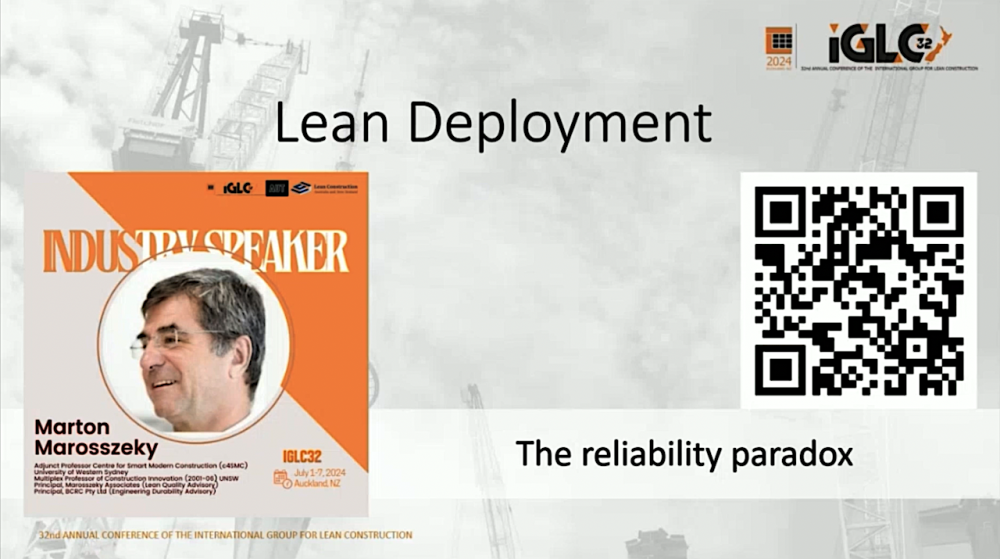
The Reliability Paradox: A New Perspective on Construction Industry Challenges
In the construction industry, where speed and cost often overshadow other priorities, the concept of reliability is both misunderstood and undervalued. Martin Marosszeky, a distinguished Professor of Management in Civil Engineering at the University of New South Wales and co-author of several authoritative books on quality in construction, recently shared insights into what he calls “The Reliability Paradox.”
His ideas challenge conventional industry thinking and highlight the critical role of collaboration and systemic change. Marton presented at the 32nd Annual Conference of the International Group for Lean Construction (IGLC)
The Problem: A Blind Spot for Error
Marosszeky highlights a troubling truth: the construction industry is blind to its own errors. From site safety walks to design meetings, the same issues are repeatedly identified but seldom resolved. This cyclical process of “band-aid” fixes perpetuates inefficiency and poor quality.
He recounts examples of systemic inefficiencies, such as rework on major infrastructure projects and the unmeasured cost of unreliability.
One notable case is a Sydney ring road project celebrated for on-time completion but has required ongoing quality fixes for over two decades.
The industry’s focus on speed and cost, driven by the fragmented nature of modern construction supply chains, has led to a culture where errors are normalised and accountability is diffused.
A Turning Point: Lessons from DPR Construction
Between 2015 and 2020, DPR Construction, a major U.S.-based contractor, implemented a systems approach to quality management. Unlike traditional checklists that provide little meaningful oversight, DPR’s system ensured that measurable acceptance criteria were defined at every project handoff. This method allowed for real-time quality assurance rather than relying on end-of-process evaluations.
The results were groundbreaking. In a comparative study of 22 projects, DPR demonstrated that improving speed, cost, and quality simultaneously is possible—a direct contradiction to the long-held “Quality Triangle” myth. By embedding reliability into every stage of the process, DPR’s projects achieved superior outcomes and cultivated teams with greater capacity for creativity and innovation.
The Real Challenge: Collaboration Across the Supply Chain
Marosszeky emphasizes that technology alone cannot address the industry’s fundamental issues. While innovations like digital twins and robotics are transformative, they cannot succeed without deep collaboration across the fragmented supply chain.
The current system often pushes the responsibility for quality down the line to subcontractors and sub-subcontractors, where the highest risks lie. Marosszeky argues that meaningful change requires engaging the entire supply chain—not just in training but in aligning goals and fostering trust.
A Path Forward: From Speed and Cost to Reliability
The construction sector must shift its focus from speed and cost to reliability. This requires rethinking the industry’s structure, which has been shaped by decades of risk fragmentation and reliance on subcontracting. Marosszeky suggests that a reliable system, built on collaboration and mutual accountability, is the only way forward.
He concludes with a sobering example from the residential construction sector, where lax regulations and unreliable practices have led to unfinished high-rise buildings years after their supposed completion. These failures underscore the need for systemic change.
The Reliability Paradox – Marton Marosszeky
Marosszeky’s insights serve as both a critique of the construction industry’s current state and a roadmap for its future.
By embracing reliability and fostering collaboration across the supply chain, the industry can achieve better outcomes for all stakeholders.
The challenge is clear:
We must go beyond superficial fixes and embrace systemic, collaborative solutions to create a capable and resilient industry. Only then can the construction sector truly build for the future.
Marton Marosszeky – Civil Engineer and Construction Innovator
Professor Marton Marosszeky is a distinguished civil engineer with a storied career in construction innovation and research. He served as the Multiplex Professor for Construction Innovation and led the BRC and ACCI research centres at the University of New South Wales. Marton is a Fellow of the Institution of Engineers and a former Fellow of the Australian Institute of Building, reflecting his deep commitment to advancing the construction industry.
A visionary leader, Marton co-founded and chaired the Lean Construction Institute of Australia from 2011 to 2015, promoting transformative approaches to construction efficiency and collaboration. He also played key roles in recognizing excellence in the field, chairing the Alliancing Association of Australasia Awards Panel (2010–2012) and the Australian Construction Achievement Award Judging Panel in 2013.
Marton’s contributions to engineering and construction extend across academia, professional organizations, and industry awards, showcasing his dedication to innovation, quality, and leadership in building a better future.

